Formula One is the pinnacle of automotive technology. But, while every engineer has dreamt of putting an F1 car on the street, there are thousands of good reasons why it didn’t happened… until 2017.
Mercedes-AMG changed that forever with its Project One car. It’s the absolute closest we can get to having an F1 car whizzing around the streets.
The review by Top Gear is one of the closest looks we’ve had of the car so far. And it’s a good chance for us to dive into some of the technology that goes underneath the beautiful body.
Mercedes-AMG One is a genuine F1 car
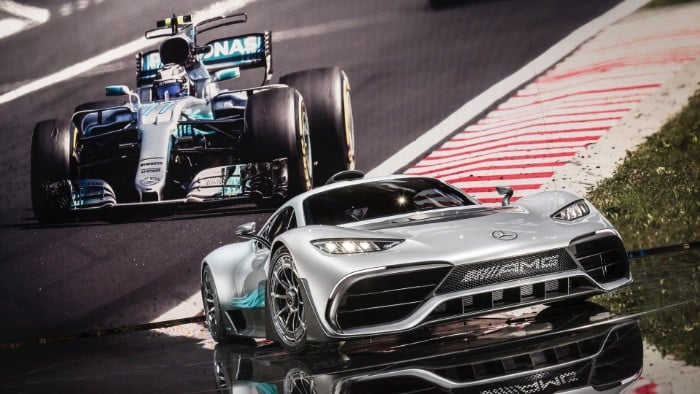
AMG completely closes the gap between Formula One and road legal race cars. This is not F1 technology applied to public road vehicles. This is not the next 1,000 horsepower supercar.
The Mercedes-AMG One is an actual Formula One car modified to meet regulations for street legal vehicles.
The rear end and drive train are taken from the Mercedes F1 Hybrid race car.
Both Lewis Hamilton and Nico Rosberg have driven this car for several Formula One seasons since 2014. Hamilton won 4 championship titles, and Rosberg took first place in 2016. In the meantime, Mercedes won 5 consecutive constructor’s cups.
Sources indicate various parts from chassis model W06 and above are used to create the final mix for AMG One. Lewis Hamilton himself participated in the development and testing of the AMG One.
No chassis
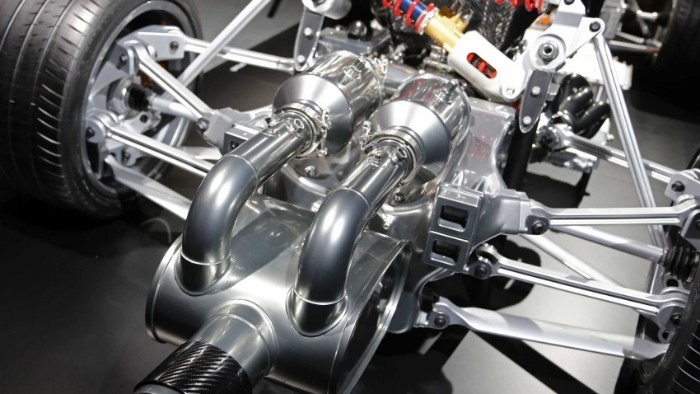
In Formula One, you don’t have the luxury of using a separate frame to carry the engine, transmission, suspension, axles, etc.
In the AMG One, the drivetrain itself becomes the chassis. The engine, transmission and differential housings are mounted directly one to another. Together they create one continuous unit to which everything else bolts on.
The control arms, shocks, and other suspension components are mounted directly to the transmission. The engine is then mounted directly to the carbon fiber cockpit where the driver sits.
Hybrid drive train with 5 motors
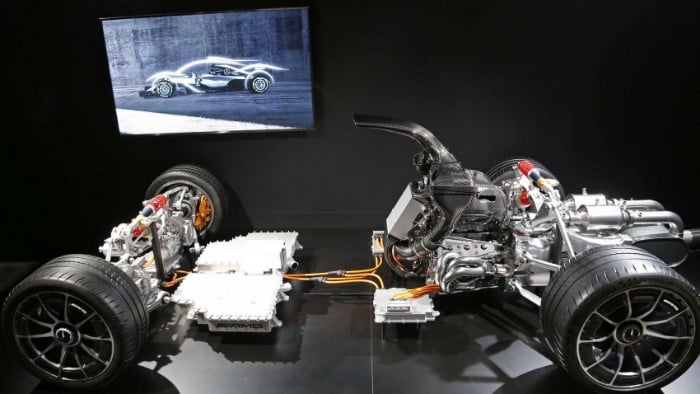
The Mercedes-AMG One is an all-wheel-drive car. It’s powered by an internal combustion engine, supplemented by four electric motors.
The main power source is a modified version of the 1.6-liter, turbocharged V6 engine drove Hamilton and Rosberg to victory. It produces 748 horsepower alone, revving up to 11,000 RPM and idling at just below 1,300 RPM. It’s slightly throttled down some from the F1 version to bring it within road legal regulations.
The engine receives help from a 161 hp electric motor directly coupled to the crankshaft. It’s a proprietary F1 Motor Generator Unit-Kinetic (MGU-K) system.
When the vehicle is braking and power is no longer needed, the motor becomes a generator. It uses the kinetic energy of the flywheel to produce electricity and charge the batteries. The unit also doubles as a starter for the engine.

The turbocharger is split with the turbine and compressor located on either side of the engine. The two halves are connected by a long shaft with another electric motor integrated along it.
It’s a Motor Generator Unit-Heat (MGU-H), providing 121 horsepower to the shaft of the turbocharger. The motor can spin up the compressor and prove maximum pressure in milliseconds.
The electric motor keeps the turbocharger spooled at low and mid engine RPM. This eliminates any turbo lag and improves throttle response. At high RPM, when the turbocharger spins faster than the motor can, the MGU-H becomes a generator, again recharging the batteries.

All of this equipment is used to generate power for the rear wheels. An 8-speed automated manual transmission takes torque through the differential mounted on its other side and out to the rear half axles.
On-demand AWD and FWD

On the front end, each wheel gets its own 161 hp electric motor, making the car all-wheel-drive.
They also come with control software that regulates the power of each motor for precise control vectoring. It improves stability and handling and helps the car rotate in the turns.
Just like the MGU-K, when the brakes are applied, the motors produce electricity for recharging the batteries.
There is a drive mode that turns the AMG One into an all-electric, front-wheel-drive car. In this mode, only the front motors drive the car with the engine shut down. The vehicle will run completely silent with a range of 15 miles on full charge.
Another drive mode runs the engine simply as a generator, while the car still functions as an EV.
These options allow remarkable convenience of the car outside the track. If you ever do city driving or school runs in this car, you might prefer to keep the engine off.
You can watch this wonderful presentation of the Mercedes-AMG One drivetrain:
Energy recuperation and efficiency
Formula One is a festival of power and efficiency. With an engine constantly revved up to over 14,000 RPM, and a limited tank capacity, fuel consumption becomes a big problem.
Every watt of energy needs to be recycled to create more useful power, without adding more weight. This makes the energy recovery system an integral part of modern F1 racing and Mercedes-AMG One inherits this technology directly.
The power regeneration technology, low displacement engine, and low weight make the car very efficient. We don’t have any mileage numbers, but we’d bet it will beat other supercars in fuel economy and emissions.
At the same time, the AMG One delivers F1 performance on the road. In maximum attack mode, all four electric motors provide an effective 272 hp to the vehicle. At full throttle, the car produces between 1,039 and 1,231 hp, draining the batteries, but giving you that record-breaking lap.
Form follows function
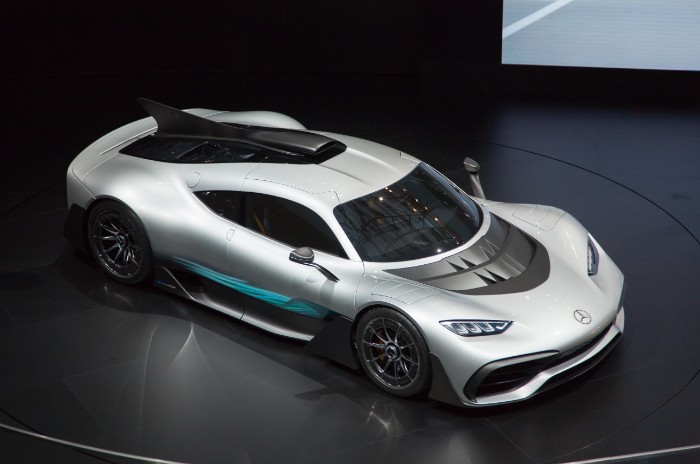
The old rule is 100% valid for the body of the Mercedes-AMG One. It’s designed strictly for aerodynamics while following all requirements for street-legal vehicles.
The forms are smooth and uninterrupted. All possible sources of drag are eliminated. The badge is airbrushed onto the paint and the wheels have inserts that cover the bolts.
The AMG One comes with electronically controlled aerodynamic surfaces. The flaps on the front intake expand or recede depending on whether you want more cooling or less drag.
The fins over the front wheels and the double rear wing deploy to produce downforce on the two axles for turning a fast corner. In the straights they close down, allowing the car to reach top speeds.
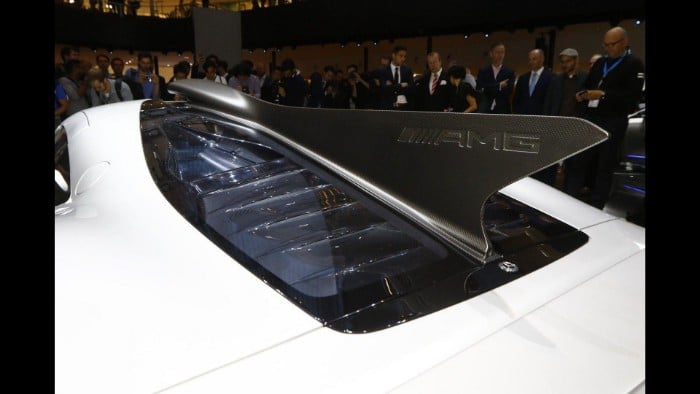
At the top, you’ll see the carbon fiber intake of the engine sticking out in its typical F1 fashion. Behind it, the large spine fin slices the air, allowing the NACA ducts on either side and the rear wing, to operate efficiently. The fin also stabilizes the car at high speeds and during cornering.
Finally, at the back, you’ll find the giant diffuser.
Minimal interior
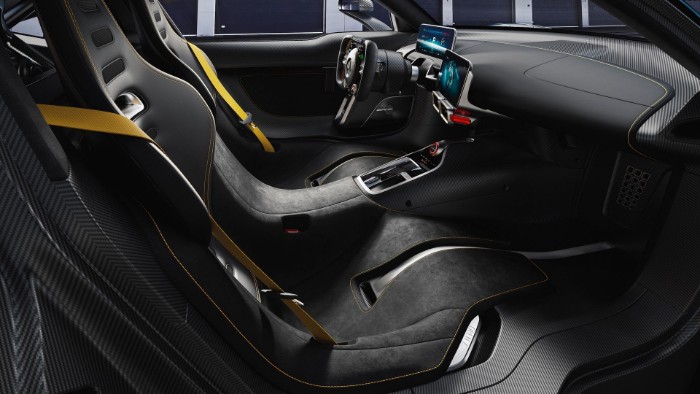
To mark one difference with its F1 counterpart, the AMG One actually has an interior… and doors. There are two seats, directly laid over the carbon fiber tub.
There is an F1 steering wheel with a number of controls and paddle shifters at the back. The steering column and pedals are adjustable to compensate the rigid seats.
Two 10-inch digital screens give you access to all the onboard settings and information you need. The rear-view mirror is also a display which is fed information from a camera at the back of the vehicle.
A couple of AC vents and a storage unit for your smartphone complete the interior. Every non-essential feature is removed to save weight.
The AMG One is not a luxurious car. However, it is a fast car.
F1 speed and performance
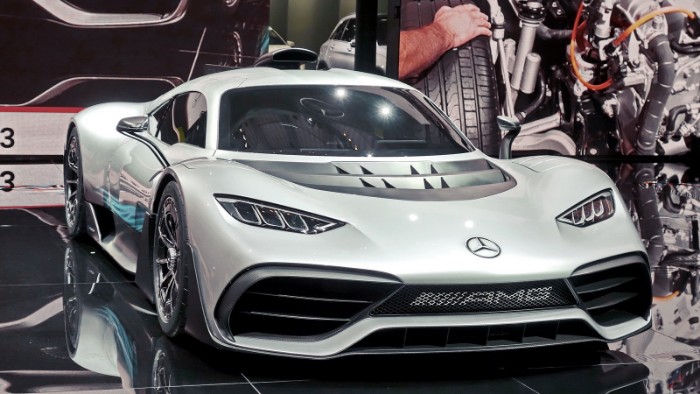
The Mercedes-AMG One is not too much slower than its F1 counterpart. The official performance stats (still in development) shared by Mercedes are:
- Top-speed: > 217 mph
- 0-62 mph: <2.5 sec
- 0-124 mph: <6.0 sec
- 0-186 mph: <11.0 sec
Nico Rosberg made a guess the car will accelerate up to 60mph in 2.2 seconds. Having won an F1 championship with the same drive train, we can’t help but take this number to heart.
And let’s not forget that an F1 race car really shines on the track – making high-G turns and crushing lap times.
Weighing in around 2,646–2,866 lbs for a power to weight ratio above 4 hp per 10lbs, the AMG One is set to obliterate records.

But we won’t find out for another year or so.
The current schedule for delivering the first cars to their owners is set for 2020. But, with a project this complicated, you can’t be too angry (or surprised) if the engineers need a couple more months.
But, we don’t have to worry about that. The Mercedes-AMG One comes with a $2.72 million price tag – with all 275 units already sold. And the engine is good for 50,000 miles, which is probably a huge improvement over the F1 version.
The closest we’re going to get is watch Nico Rosberg personalize his and, hopefully, see him on the track setting record lap times.